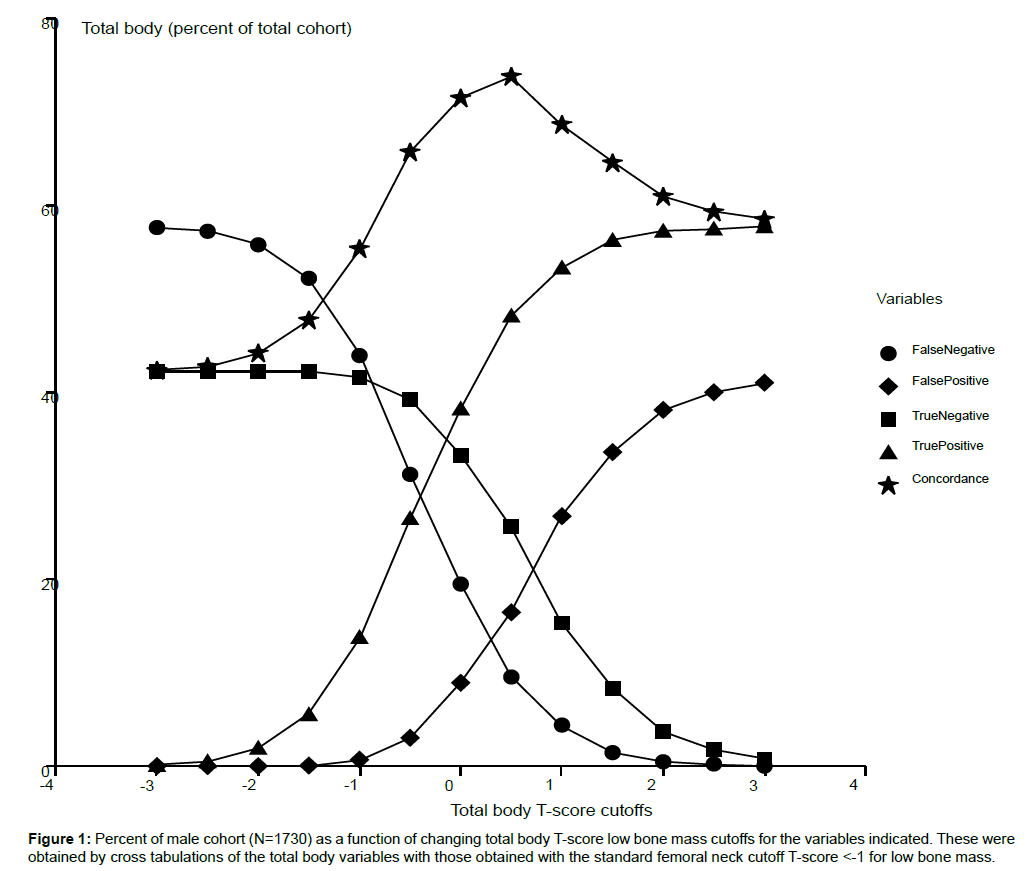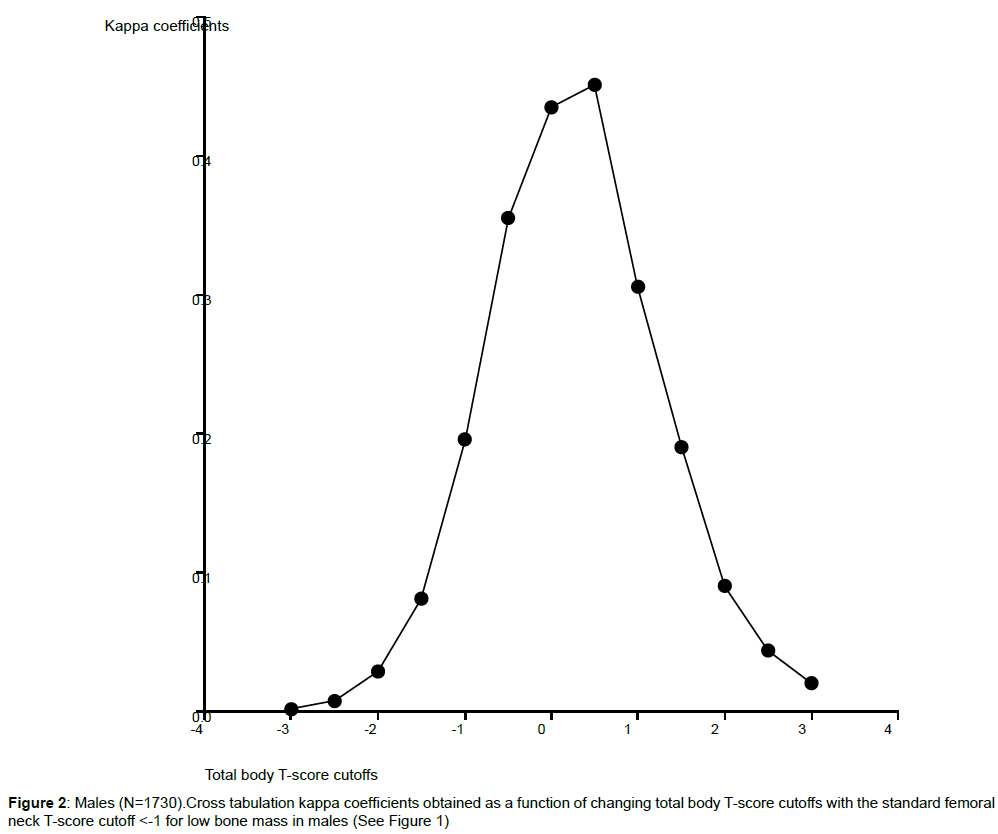Research Article, J Clin Nutr Metab Vol: 2 Issue: 1
The Relationships between Total Body, Lumbar Spine and Femoral Neck Bone Mineral Density T-Scores for Diagnosis of Low Bone Mass in HIV-Infected Patients
Leonard Rosenthall1*, Julian Falutz1 and Giovanni Guaraldi2
1Faculty of Medicine, McGill University, Montreal, Canada
2Department of Medicine, University of Modena and Reggio Emelia, Modena, Italy
*Corresponding Author : Leonard Rosenthall
McGill University Health Center, 1650 Cedar Avenue, Montreal, H3G 1A4, Canada
Tel: (514) 934 1934
E-mail: leonard.rosenthall@mcgill.ca
Received: December 11, 2017 Accepted: January 02, 2018 Published: January 09, 2018
Citation: Rosenthall L, Falutz J, Guaraldi G (2018) The Relationships between Total Body, Lumbar Spine and Femoral Neck Bone Mineral Density T-Scores for Diagnosis of Low Bone Mass in HIV-Infected Patients. J Clin Nutr Metab 2:1.
Abstract
Background: The total bone mineral density T-score cutoff for low bone mass underestimates the frequency shown by femoral neck and lumbar T-score cutoffs.
Objective: To determine whether a total body DXA T-score cutoff can be found that will produce results similar those obtained by local measurements of the femoral neck and lumbar spine.
Methodology: Participants were all HIV-infected; 1730 males and 840 females. T-score correlations of the three sites were obtained. ROC analyses were performed to obtain the T-score cutoffs for the total body that would produce results that best matched those of the femoral neck and lumbar spine. Low bone mass was defined as a T-score <-1, which includes both osteopenia and osteoporosis categories as defined by the World Health Organization (WHO). The efficacy of the derived T-score cutoffs were determined by cross tabulation of the modified total body classifications against the femoral neck and lumbar spine classification, and rated by the kappa coefficient of agreement and percent of agreement (concordance).
Results: Spearman rank correlations varied from 0.570 to 0.752 between total body, lumbar spine and femoral neck T-scores. Area under the ROC curve varied from 0.777 to 0.874 for the different paired sites. The T-score cutoffs for the total body were selected from the ROC curves at a point where the sum of the sensitivity and specificity is a maximum. Cross tabulation of the binary categories. i.e., normal or abnormal, of the total body using the derived T-score cutoffs against those of the femoral neck and lumbar spine registered a reduction of false negatives, but it was associated with a consistent increase in the number of false positives. The resultant kappa coefficients of agreement varied from 0.429 to 0.564; a moderate rating when perfect agreement is 1.0.
Conclusion: The modification of the total body T-score cutoffs for the disclosure of low bone mass at the femoral neck and lumbar spine is not sufficiently accurate for clinical application, in particular fracture risk prediction.
Keywords: DXA; Low bone mass; Skeletal sites
Introduction
There is an increasing use of total body DXA scanning for the measurement of bone and soft tissue components, but the role of total body bone mineral density (BMD) T-score in fracture prediction is debatable [1-4]. The degrees of reported concordance and discordance between total body BMD T-scores and those of the lumbar spine and hip have been variable, as well between lumbar spine and hip T-scores [5-10]. The following is an analysis of the relationship of the total body BMD T-scores with those of the femoral neck and lumbar spine in a large cohort of 1730 males and 840 females who are HIVinfected, a disease that is associated with an increased prevalence of low bone mass and fractures relative to the normal population [11,12]. The prime objective in this study was to determine whether the BMD cutoff T-scores of the total body for low bone mass could be changed to agree with the results of the femoral neck and lumbar spine T-score cutoff for low bone mass.
Patients and Method
This cross-sectional study is a retrospective analysis of routinely obtained clinical and laboratory data collected during follow-up of HIV-treated patients at the Modena HIV Clinic. There were 1730 males and 840 females who had total body, lumbar spine (L1-L4) and femoral neck DXA scans (Hologic 4500 QDR Elite, Hologic Inc., Bedford, MA) (Table 1).
| Males* | Females* | |
|---|---|---|
| Duration of HIV infection (months) | 205 (127,268) | 233 (177,277) |
| Age (years) | 48 (44,56) | 46 (43,50) |
| CD4 count nadir (cells) | 200 (84,300) | 187 (75,272) |
| CD4 count | 583 (426,764) | 592 (435,771) |
| Undetectable HIV viral load (%) | 78 | 80 |
| Glucose (mmo/L) | 5.2 (4.8,5.7) | 5.0 (4.7,5.3) |
| Insulin (pmo/L) | 59.7 (38.9,96.5) | 58.3 (38.2,93.1) |
| HOMA | 1.98 (1.24,3.39) | 1.85 (1.19,3.03) |
| Total cholesterol (mmo/L) | 4.9 (4.1,5.6) | 5.1 (4.3,5.9) |
| LDL cholesterol (mmo/L) | 3.0 (2.5,3.6) | 2.9 (2.4,3.5) |
| HDL cholesterol (mmo/L) | 1.1 (0.9,1.3) | 1.4 (1.1,1.7) |
| Triglycerides (mmo/L) | 1.6 (1.2,2.3) | 1.3 (1.1,1.9) |
| Body fat (%) | 19.2 (14.1,24.0) | 26.2 (21.3,31.4) |
| Weight (kg) | 71 (65,79) | 58 (52,64) |
| BMI | 23.8 (21.9,26.1) | 22.0 (20.2,24.5) |
| Waist circumference (cm) | 88 (82,94) | 83 (77,89) |
| Trunk fat (kg) | 7.2 (5.2,10.1) | 7.4 (5.4,9.8) |
| Visceral adipose tissue (cm2) | 124 (80,176) | 96 (61,127) |
Table 1: Descriptive characteristics of patients.
Statistical Analysis
The relationships between T-scores of the three skeletal sites were assessed by the Spearman rank correlation coefficients. Cross tabulations provided kappa coefficients of agreement and percent concordance (percent correctly diagnosed) between two sites. In order to obtain a cutoff T-score for the total body measurements to best match the categories of the femoral neck or lumbar spine, ROC curve analysis was performed wherein the criterion variable was the total body T-score and the condition variable was either the femoral neck or lumbar spine binary categories, i.e., normal or low bone mass. The selected T-score cutoffs for cross tabulations were determined by the peak Youden index (maximum {sensitivity + specificity}-1).
Results
Median T-scores for the BMDs of the total body, lumbar spine and femoral neck were 0.1, -1.1 and -1.2, respectively, for males. These were significantly different from each other by the Dunn’s test. Significant differences were also obtained for the female total body, lumbar spine and femoral neck median T-scores of 0.2, -0.8 and -1.2, respectively. The prevalence of low bone mass, i.e., T-score <-1.0, for the femoral neck was 57% in males and 58% in females. Lumbar spine low bone mass prevalence was 56% in males and 47% in females, and considerably less in total body at 11% and 14% in males and females, respectively. Moderate BMD Spearman rank correlations were obtained between total body and femoral neck, total body and lumbar spine, and lumbar spine and femoral neck of 0.632, 0.707 and 0.570, respectively, for the male cohort, and 0.683, 0.752 and 0.654, respectively, for the female cohort (Table 2).
| T-scores | Males (N=1730) Rho (95%CIL) | Females (N=840) Rho (95%CIL) |
|---|---|---|
| Total body & Femoral neck | 0.632 (0.600,0.662) | 0.683 (0.641,0.716) |
| Total body & Lumbar spine | 0.707 (0.680,0.732) | 0.752 (0.717,0.783) |
| Lumber spine & Femoral neck | 0.570 (0.534,0.603) | 0.654 (0.609,0.695) |
Table 2: Spearman rank correlations.
The results of the total body ROC curve analyses are given in Table 3 and those of cross tabulation in Table 4. The cross tabulation results show that there is an inverse relationship between the false negatives and false positives when applying the ROC analysis derived total body T-scores. For example, from Table 4, the total bodyfemoral neck comparison in males show a decrease in false negatives from 801 to 225 and a corresponding increase in false positives from 7 to 227. Figure 1 is a graphic depiction of the changes in the percent of the descriptive variables in the entire male cohort as a function of total body T-score cutoffs.
| Gender | Criterion Variable | Condition* variable | AUC (95% CIL) | Total body** T-score cutoff | TPR | TNR | PPV | NPV | Kappa |
|---|---|---|---|---|---|---|---|---|---|
| Males | Total body T-score | Femoral neck | 0.809 (0.748,0.928) | = -0.30 | 0.775 | 0.689 | 0.773 | 0.691 | 0.464 |
| Males | Total body T-score | Lumbar spine | 0.842 (0.823,0.859) | = -0.01 | 0.676 | 0.837 | 0.823 | 0.697 | 0.488 |
| Females | Total body T-score | Femoral neck | 0.852 (0.795,0.851) | = -0.20 | 0.719 | 0.770 | 0.813 | 0.664 | 0.478 |
| Females | Total body T-score | Lumbar spine | 0.874 (0.874,0.895) | = -0.1 | 0.801 | 0.770 | 0.724 | 0.837 | 0.564 |
*Binary category, wherein the low bone mass T-score <-1.0 ** T-score cutoff derived from the AUC curve at the point where the Youden index is maximum
Table 3: ROC results.
| Condition* variable | Number | TB T-score cutoff | False negatives (% of cohort) | False positives (% of cohort) | Concordance (% of cohort) | Kappa |
|---|---|---|---|---|---|---|
| Males 1730 | ||||||
| Lumbar spine | <-1.0 | 780 (45.1%) | 6 (0.34%) | 1282 (74.1%) | 0.174 | |
| Lumbar spine | =-0.1 | 334 (19.3%) | 114 (6.6%) | 1363 (78.7%) | 0.488 | |
| Femoral neck | <-1.0 | 801 (46.3%) | 7 (0.40%) | 922 (53.2%) | 0.164 | |
| Femoral neck | =-0.3 | 225 (13.0%) | 227 (13.0%) | 1278 (73.0%) | 0.464 | |
| Females 840 | ||||||
| Lumbar spine | <-1.0 | 279 (33.2%) | 5 (0.60%) | 556 (66.2%) | 0.289 | |
| Lumbar spine | =-0.1 | 72 (8.6%) | 110 (13.1%) | 658 (78.3%) | 0.563 | |
| Femoral neck | <-1.0 | 374 (44.5%) | 4 (0.40%) | 462 (55.0%) | 0.198 | |
| Femoral neck | =-0.2 | 137 (16.3%) | 81 (9.6%) | 662 (74.0%) | 0.478 |
Table 4: Cross tabulations. Comparison of changes with ROC total body derived T-score cutoffs and the standard T-score <-1 cutoff for low bone mass.
The kappa coefficients of agreement increased significantly with the cutoffs derived from ROC curve analyses in both males and females for the total body-femoral neck and total body-lumbar spine pairs. Prior to the change in total body T-score cutoffs the kappa coefficients ranged from 0.164 to 0.284 in the different pairs, whereas they ranged from 0.464 to 0.563 afterward. In contrast, there was no significant improvement in the lumbar spinefemoral neck pair in females and males (Table 4). An example of the variation in kappa values as a function total body T-score cutoffs is given in Figure 2.
The effect of age on the kappa values was assessed by comparing patients above the median age to those who were below or equal to the median age. Median age for males was 48 years and 46 years for females. Cross tabulations were obtained with T-score cutoffs for low bone mass at <-1.0 and compared to those of the ROC derived T-score cutoffs. There were no significant differences between the 2-quantiles as a result of the T-score cutoff modification in both males and females; inferring that the kappa coefficient is independent of age.
Discussion
The area under the curve of ROC analysis, a measure of the accuracy of diagnosing femoral neck low bone mass from the total body and lumbar spine T-scores, varied from 0.777 to 0.842 in males and 0.775 to 0.874 in females (Table 3). A characteristic of the results was a decrease in the number of false negatives with a persistent increase in false positives. A similar inverse relationship occurred with the true positives and true negatives (Figure 1). In spite of these good AUCs, the T-score cutoffs derived from the ROC curve at the point of maximum Youden index yielded inadequate increases in kappa coefficients of agreement in the paired cross tabulations (Table 4). They varied from 0.429 to 0.563 for the entire cohort which is considered a moderate rating compared to 1 for perfect agreement. The moderately improved level of concordance for the cohort ranged from 73% to 78%. An exception was the lumbar spine-femoral neck pair wherein there was no clinically significant change in kappa coefficient and concordance.
There is a parallel relationship between the kappa coefficients and the concordance in that they both rise and fall as a function of T-score cutoff and peak at virtually the same cutoff that closely approximates the T-score cutoff derived from the ROC analysis. They reflect different measures of agreement. Concordance is the number of agreements, i.e., the sum of the true positives and the true negatives divided by the total cohort. The kappa coefficient is a measure of agreement beyond chance, and is probably a more stringent metric. The low kappa values obtained when the same T-score cutoff of <-1 is used for the three scanning sites can be attributed to the differences in each site of the relative content of cortical and trabecular bone. The total body measurement includes 80% cortical bone and 20% trabecular bone [13]. Femoral neck is composed of 57% cortical bone and 43% trabecular bone, and the lumbar spine is 66% cortical and 34% trabecular bone [14,15].
The shortfall in the kappa coefficient and concordance improvement with the total body T-score cutoff modifications negates the total body measurement as a possible surrogate for the femoral neck to predict the probability of fracture risk using the FRAX calculation tool [16]. These results agree in some measure with other reports on smaller populations of COPD and rheumatoid arthritis [1,3,17]. A limitation of this study was the absence of a control cohort.
Conclusion
It is advisable to obtain direct measurements of the lumbar spine and femoral neck to determine the bone mass status for fracture risk prediction and treatment management, and dismiss the total body BMD T-scores for those purposes.
References
- Graat-Verboom L, Spruit MA, van den Borne BE, Smeenk FW, Wouters EF (2010) Whole body versus local DXA scan for the diagnosis of osteoporosis in COPD patients. J Osteoporosis.
- Franck H, Munz M (2000) Total body body regional bone mineral densitometry (BMD) and soft tissue measurements: correlations of BMD parameter to lumbar spine and hip. Calif Tissue Int 67: 111-115.
- Rajael A, Dehghan P, Ariannia S, Ahmadzadeh A, Shakiba M, et al. (2016) Correlating whole-body bone mineral densitometry measurements to those from local anatomical sites. Iran J Radiol 13: e25609.
- Sakai Y, Koike G, Numata M, Taneda K, Jinqum S (2010) Whole body bone mineral density measured by the dual energy x-ray absorptiometry among Japanese adult females. Fukuoka Igaku Zasshi 10: 69-64.
- Woodson G (2000) Dual x-ray absorptiometry T-score concordance and discordance between hip and spine. J Clin Densitom 3: 319-324.
- O’Gradaigh D, Debiram I, Love S, Richards HK (2003) A prospective study of discordance in diagnosis of osteoporosis using proximal femur densitometry. Osteoporosis Int 14: 13-18.
- El Maghraoui A, Mouinga A, Ghozlani I, Mounach A, Nouijai A, et al. (2007) Prevalence and risk factors of discordance in diagnosis using spine and hip bone densitometry. Ann Rheum Dis 66: 271-272.
- Nelsson DA, Molloy R, Kleerekoper M (1998) Prevalence of osteoporosis in women referred for bone density testing: Utility of multiple sites. J Clin Densitom 1: 5-11.
- Kanis JA, Seeman E, Jonell O, Rizzoli R, Delma P (2005) The perspective of the International Osteoporosis Foundation on the effective positions of the International Society for Clinical Densitometry. Osteoporosis Int 16: 456-469.
- Arabi A, Badduoura R, Awada H, Khoury N, Haddad S, et al. (2007) Discriminatory ability of dual-energy X-ray absorptiometry site selection in identifying patients with osteoporotic fractures. Bone 40: 1060-1065.
- Triant VA, Brown TT, Grinspoon SK (2008) Fracture prevalence among human immunodeficiency virus (HIV)-infected patients versus non-HIV-infected patients in a large U.S. healthcare system. Clin Endocrinol Metab 3: 3499-3504.
- Young B, Dao CN, Bucharz K, Baker R, Brooks JT (2011) Increased rates of bone fracture among HIV-infected persons in the HIV Outpatient Study (HOPS) compared with US general population, 2000-2006. Clin Infect Dis 52: 1061-1068.
- Riggs BL, Melton LJ, Robb RA, Camp JJ, Atkinson EJ, et al. (2008) Population based assessment of rate of bone loss at multiple sites: evidence for substantial trabecular bone loss in young adult women and men. J Bone Miner Res 23: 205-214.
- Bohr H, Schaad O (1985) Bone mineral content of the femoral neck and shaft: relation between cortical and trabecular bone. Calcif Tissue Int 37: 340-344.
- Eastell R, Mosekilde L, Hodgson SF, Riggs BL (1990) Proportion of human vertebral body that is cancellous bone. J Bone Miner Res 5: 1237-1241.
- Kanis JA, Johnell O, Oden A, Johensson H, McCloskey E (2008) FRAX and the assessment of fracture probability in men and women from the UK. Osteoporosis Int 19: 385-397.
- Mounach A, Abayi DA, Ghazi M, Ghoziani I, Nouijai A, et al. (2009) Discordance between hip and spinal bone mineral measurements using DXA: prevalence and risk factors. Semin Arthrits Rheum 38: 467-471.
 Spanish
Spanish  Chinese
Chinese  Russian
Russian  German
German  French
French  Japanese
Japanese  Portuguese
Portuguese  Hindi
Hindi 

